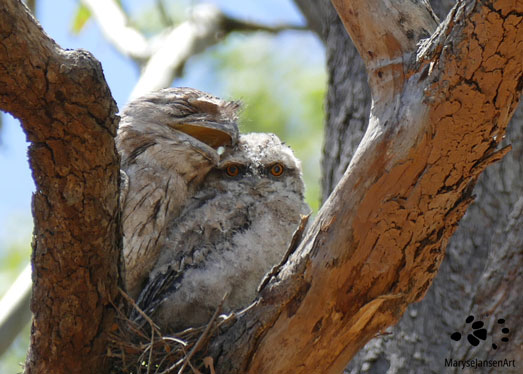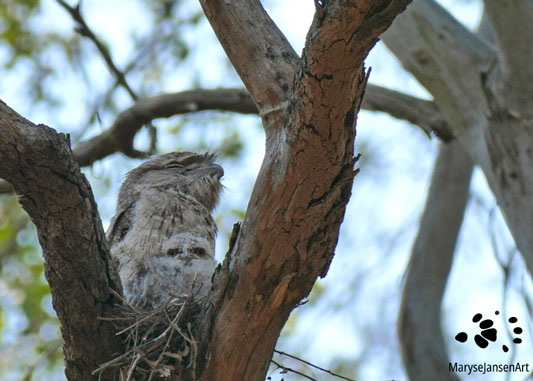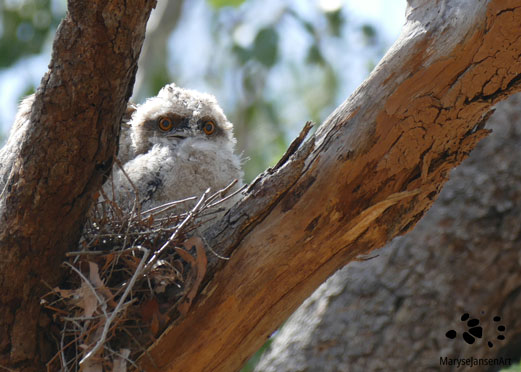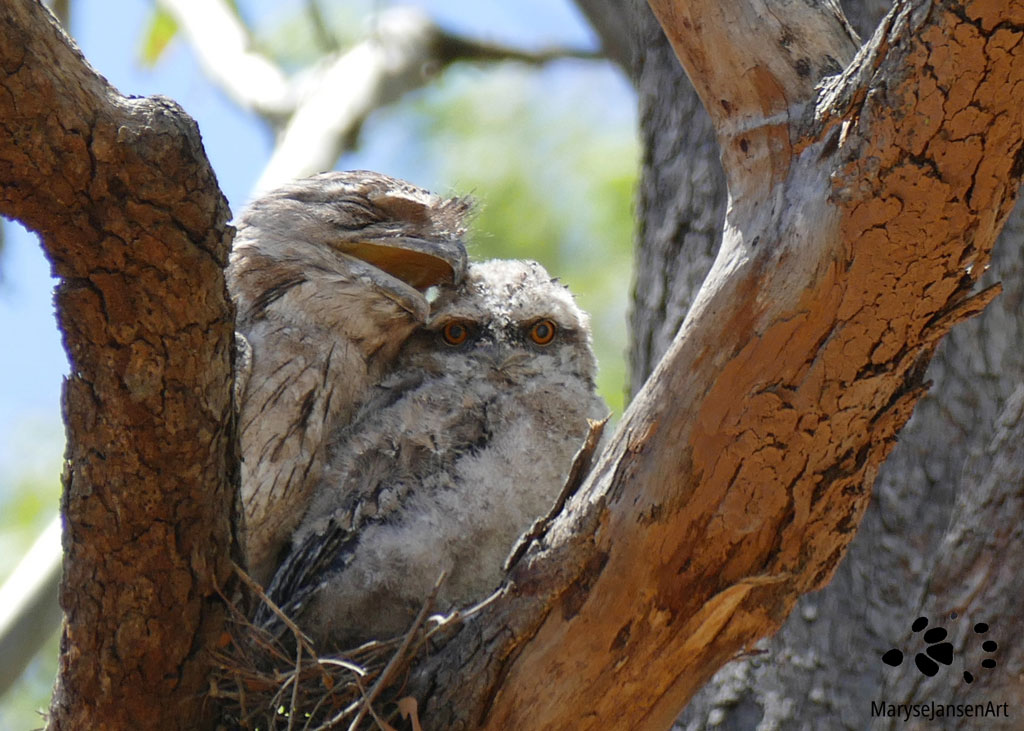Bird Photography with marysejansenart
Following a Tawny Frogmouth nest

Awww! I can’t believe how cute it is! I’ve been walking past this point in anticipation for a couple of weeks now, ever since I’ve spotted the Tawny Frogmouth nest. It takes about 4 weeks for the eggs to hatch and then another 4 weeks for the chick(s) to leave the nest. November & December is the prime breeding season. The nest doesn’t look like much, it’s merely a loose platform of sticks, positioned on a horizontal forked tree-branch. I keep wondering how this nest survives the strong wind gusts of our summer thunderstorms.
Table of Contents
Champions of camouflage
Tawny Frogmouths are very interesting birds. Often thought to be owls, they are actually much closer related to the night jar. These birds are the champions of camouflage! Their mottled grey-brown feathers blend perfectly with the branches of the trees they occupy. In fact, they actively do their best to look like a tree branch by assuming a stiff posture with their head turned upwards.
The birds can hold this position for many hours! They seem to be sleeping but they peer through their eyelids to keep an eye on what goes on around them. The reason they reduce their eyes to slits is that their gorgeous big bright yellow eyes would totally defeat their attempt to camouflage. These eyes really stand out!
The growing chick
For the first time I get a look at the little white fluffy thing that is the Tawny Frogmouth chick. It’s a brief glimpse but it’s so cute, I’m hooked! I decide to keep coming back to see how the chick is growing.

It doesn’t always show itself, oftentimes it’s hiding under dad’s feathers. Yes, it’s the father that looks after the chick! When breeding mum and dad take turns in sitting on the egg during the night so that both birds get the opportunity to hunt for food. During daytime however, the male takes the whole shift! The mother usually roosts in a nearby tree. And once the chicks have hatched it all comes down to the father to raise his offspring. A normal clutch size is 2-3 chicks. I’ve only seen 1 chick on this nest though.
The chick is growing fast! In week 2 the white down has already changed colour to pale grey and some feathers are beginning to form. I can see it’s learning fast, copying its father’s behaviour. On one of my visits I find the couple, father and child, playing branch perfectly.
They really look like they’re sleeping. But I can see that the father is perfectly aware of what’s going on around him. Or ‘downstairs’ on this occasion, as I’m down there observing them and taking photos. Occasionally he tilts his head slightly and peeks through his eyelids. Curiosity gets the better of the little one and it pokes its head over the edge of the nest to get a closer look at me. My heart melts, it is so adorable!
I love those big yellow eyes! The Tawnies, as Australians affectionately like to call them, have such great expressions! I know I’m not the only one that likes them, Tawny Frogmouths are a very popular bird in Australia!

A tree to call home
Tawnies need woodland to live in and a mature tree to roost on, where they can be safe during the day, blending in with their environment. You can find them throughout most of Australia, but due to their excellent camouflage they can be very difficult to spot!
Often, when they choose a tree to call home, they stay there for many years. Spending the days sitting still, mimicking a broken tree branch. They usually pick a branch close to the trunk of the tree to roost on, which makes them even more difficult to see. Most of the time you wouldn’t notice them, but once you know their spot you’ll be sure to see them coming back there.
At night, they will go out and hunt. They can catch their prey in flight or by swooping down from a tree to catch prey on the ground. Tawnies mostly eat insects, spiders, centipedes, worms, slugs and snails. Sometimes they have a go at larger prey such as frogs and small birds, reptiles and mammals. Unlike owls (who catch prey with their talons) they catch prey with their beak. Their feet are quite small compared to an owls talons.
They rarely make a noise, but occasionally may be found ‘oom oom oom ooming’: a soft and low repeated booming sound. When they are threatened they puff themselves up and make loud hissing noises. They open their eyes and beak wide to look as scary as possible. Their broad, wide beaks have given them the name Frogmouth.
Tawny Frogmouths mate for life. They can live up to 14 years.
The Tawny Frogmouth chick grows up
I’m back at the nest. The time is approaching that the chick will fledge, which happens at about 4 weeks after hatching. At that moment it will be able to leave the nest and perch on a nearby branch. It looks like dad is aware that his little one is growing up and he’s is really enjoying the company while its lasts. My favourite photo in the series is this one, which I call “Tawny Frogmouth Cuddle” and is the featured image in this post.
One week later, the chick is indeed fully fledged and learning to fly and hunt. I only see it one more time, roosting on a neighbouring tree, on a branch close to its father. It’s ready to fly out and build it’s own life!
If you are interested in purchasing ‘Tawny Frogmouth Cuddle’ or would like to see what it looks like on the various products, please head to my shop. Or if you prefer ‘Curious Tawny Frogmouth Chick, click shop here!


